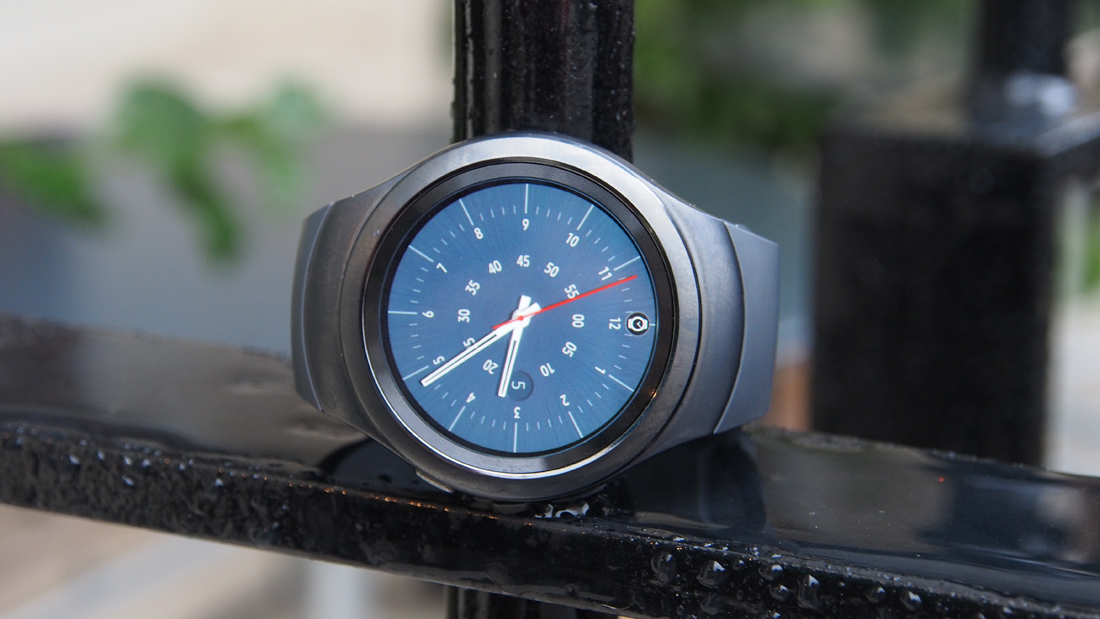Why you can trust TechRadar
The Samsung Gear S2 functions like any other smartwatch, it alerts you to texts, emails and other smartphone notifications, tracks your steps, a runs a number of apps.
When you receive a smartphone notification, the watch vibrates, and displays the message. You can choose to dismiss it, or interact with it.
In order to make the most of the rotating bezel, Samsung has decided the Gear S2 should run its own Tizen operating system. This is a risky strategy, which has both positive and negative repercussions.
Of course, as well as using the bezel to navigate the device, you could also use the touch screen. Although I rarely found myself doing that while testing.

We'll start with the positives, first by looking at Samsung's main rivals, neither of which have a perfect operating system. The Apple Watch is very fiddly, and has a lot of functions hidden away behind Force Touch, which is not as intuitive as it should be.
In comparison, Android Wear is much more intuitive, but it requires a lot of swiping and tapping to navigate, which isn't ideal on such a small screen. Although you can use voice control on both, if you're socially ready for that.
The Gear S2 takes the best of each OS, and combines them to create the best UI we've seen on a smartwatch. Tizen is very similar to Android Wear, with your home screen watch face, and then different cards for at-a-glance information. Whereas navigating the cards on Android Wear requires furious swiping, those in Tizen can be viewed with one fluid twist of the bezel.
While Android Wear is coming on leaps and bounds, Google doesn't let manufacturers apply their own UIs, so Tizen really helps to differentiate the Gear S2 from the hoard of Android Wear watches out there.
From the watch face rotating the dial clockwise scrolls through information cards, these tell you information such as steps taken, calendar appointments, weather, music controls and shortcuts to other functions, such as apps and favourite contacts. Tap on these pages, and more information is displayed about them.

Rotate the bezel anti-clockwise and you're shown the most recent notifications from your smartphone, including emails, texts and missed calls. Tapping on an email allows you to read the entire text, scrolling down using the rotating bezel. Tapping on the three dots to the left of a message brings up the options, allowing you to archive, delete, reply, open on phone, block or clear all notifications.
Reply to messages can be done one of three ways, either with programmable set messages, emoji, or using a T9-esque predictive keyboard.
Apps are presented as one long list with multiple pages which you can scroll through with the bezel. It's not as simple as the Apple Watch app list (but it is less fiddly), and easier to navigate than Android Wear.
Pressing the button near the five o'clock position will either take you to the app page, or home, depending where you are, and the button at the two o'clock position will send you back one screen. These buttons can take some getting used to, but they make navigating a breeze.
If you long press on the lock screen you're given the option to change watch faces, and unlike the Google Now cards on Android Wear, the cards of information on Tizen can be organised, so you can see the information you want first. That's a big benefit.

Watch faces are plentiful, and Samsung provide some pleasing options to customise their standard designs (change the dial, complications or hands, for example). This is best done on the companion smartphone application.
One of our favourite features has to be an SOS alert. Pressing the 5 o'clock button three times in quick succession sends an SOS alert to a selected contact, along with your GPS location. Very James Bond.
As I mentioned, the Gear S2 bezel controller is a real breakthrough. That's just as well, since the other way of interacting with the watch - voice control - is pretty poor.
You can wake up voice control with a programmable command, just like 'OK Google', or 'Hey Siri'. We went with 'S Voice', the name of the software. It takes what feels like an age to wake up, and once awake doesn't get much faster. It's definitely enough to put you off voice control, but may be adequate in emergency situations.
Specs and performance
The Samsung Gear S2 packs a 1GHz processor and 512MB of RAM. That's only a tad lower spec than the high-end Android Wear devices, which have 1.2GHz processors. Actually, the same chipset has recently appeared in the Samsung Gear Fit 2 and the Gear Fit 2 Pro, the company's fitness trackers.
Apps generally open quickly, but larger, more processor intensive apps such as Here Maps can take a while to load.

The Gear S2 has 4GB of storage on board for music and apps, which is plenty. I'm nowhere near filling it up.
The Tizen OS is snappy and responsive, and I didn't experience any slowdowns during testing.
In terms of sensors, Samsung has included an accelerometer, gyroscope, heart rate sensor, ambient light sensor, and barometer.
There's no GPS, so it's not going to serve as a proper running watch, despite its sporty styling. Saying that, it'll still count your steps and monitor your heart rate throughout the day, this can be viewed on your smartphone by downloading the Samsung S Heath app.
The watch connects to your smartphone with Bluetooth 4.1, and further connectivity options appear in the form of Wi-Fi and NFC.

Wi-Fi isn't new for a smartwatch, but it's a great inclusion, meaning the watch can continue to receive notifications even if your phone is elsewhere.
NFC is used for Samsung Pay contactless payment, which only works if you also have a Samsung phone.
Current page: Interface, specs and performance
Prev Page Introduction, price and design Next Page Apps, compatibility and battery life